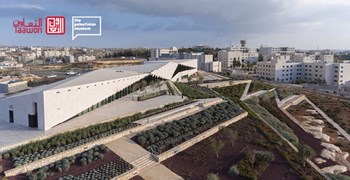A series of art installations celebrating the birth of the Palestinian Museum
Ramallah 18/6/2016 - This evening, the Palestinian Museum celebrates the inauguration of its brand new building, with a selection of artworks and performances designed to express the cultural vision of the museum, and its commitment to the embrace and preservation of Palestinian memory. These performances and displays will introduce the Museum to the world, showcasing its message and its intellectual contribution - as well as its beautiful building, which stands high on the hills above Birzeit, overlooking the Mediterranean Sea. It will also be an opportunity to thank all those who have contributed to this great achievement:
The idea for the art installations came from Palestinian theatre director and artist Amir Nizar Zuabi. He worked alongside a troupe of dancers led by choreographer Samar Haddad King, as well as a selection of individual musicians from different parts of Palestine, led by composer Faraj Suleiman. Also taking part were a group of Italian artists, under the leadership of light artist Marco Nereo Rotelli. They have worked together to present the Palestinian Museum with unique and diverse set of displays inspired by the Museum building itself, and its gardens: the performances are designed to complement and reflect on the Palestinian natural environment. They also engage with material from the Palestinian Museum’s archives, which it has recently begun amassing, and with the concepts of Palestinian culture and identity.
Guests will be greeted upon their arrival with a performance of live jazz. They will then be accompanied on a tour of the museum’s glass gallery and the exhibition hall, where they will witness a beautiful performance piece celebrating the work of building the museum, by five dancers and well-known singer Rasha Nahhas. Following the performance, guests will pass through the glass gallery: there, they will gather to trace on its floors a mental map of Palestine, from its major cities to the camps of the diaspora. This will be a moment of reflection: a chance for everyone to remember the broader issues of which they are a part. At the same time, guests will be able to enjoy, through the glass, the sigh of the sun setting over the museum gardens and the beautiful surrounding landscape.
After this, the guests will move outside, to wander through the museum gardens and enjoy the music performed by the musicians scattered across them. They will be playing a selection of the many classical and popular Arabic songs related to the themes of flowers and gardens, newly arranged by composer Faraj Suleiman. Some of these songs will be sung by the wonderful Lina Sleibi.
The main event, however, will take place in the museum’s amphitheatre. It is here that the guests will be able to celebrate together the birth of the Palestinian Museum, honouring those who have helped to make this dream a reality. Then the main display, a light installation by Marco Nereo Rotelli which was designed specifically for the opening and which constitutes the culmination of the evening, will begin. Drawing inspiration from the museum’s archive, it traces the Palestinian narrative in a series of poetic images, a stunning light display projected on to the museum building’s external facades. Engaging with themes of identity and culture, the light display is interpolated with handwritten Arabic writings and Palestinian poetry: an exceptional visual performance that beautifully expresses the message of the museum.
The Palestinian Museum dedicates this evening, and the artworks and performances within it, to all those martyred and injured in their struggle for justice, dignity and freedom in Palestine; to those in the diaspora whose right to return has been stolen from them; to those kept unjustly behind bars; and to all those who are besieged, and still steadfast, within their own homeland.
NB: It will be possible to watch live broadcasts of the ceremony on the Palestinian Museum’s website, and onscreen at Palestine TV.
For more information: media@palmuseum.org












